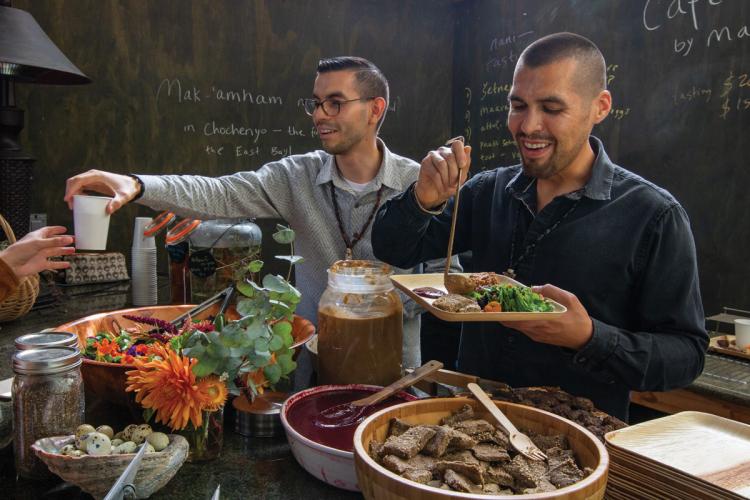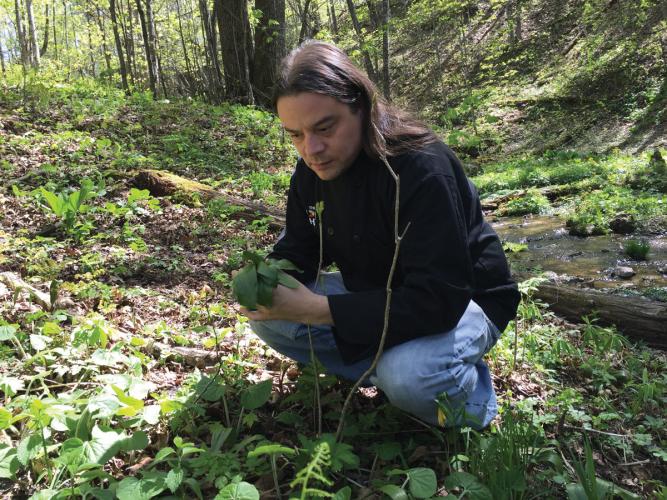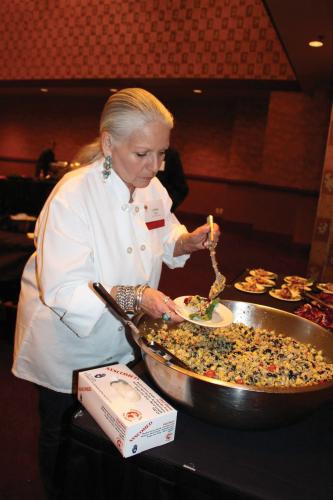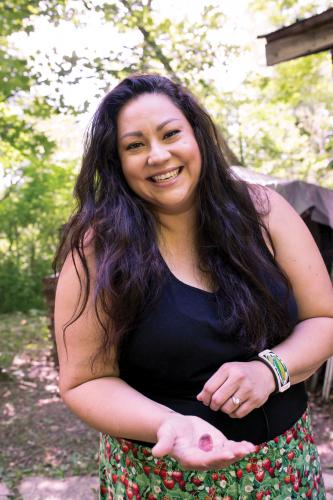For chefs Vincent Medina and Louis Trevino, late autumn is the time for “yuu,” or acorns, a traditional staple for the Ohlone people of California’s northern coast. “Big, fat acorns begin to drop in fall, and that begins the start of a long process of gathering, storing, drying, shelling, peeling, winnowing, grinding and leaching until the acorn is ready to be served as a creamy, sweet soup or crusty, gelatinous ball of acorn bread,” they recalled last year in a post on their Cafe Ohlone website.
Cafe Ohlone was not just a business when Medina (Chochenyo Ohlone) and Trevino (Rumsen Ohlone) opened it in Berkeley, California, in September 2018. It was part of a larger revival of Ohlone culture and language, shaped by the traditional foods that their elders remembered. Then in March 2020, Cafe Ohlone closed, another victim of the COVID-19 pandemic.
Since COVID-19 restrictions have prevented groups of people from gathering, restaurants across the world have closed or temporarily shuttered, including National Museum of the American Indian’s Mitsitam and Mili Kàpi Cafes. Native-owned restaurants or those serving Native cuisine have been hit hard.
In Indigenous communities, this loss comes with additional price. Some of these restaurants have been reviving their ancestors’ food traditions and have become a critical source of food for elders and others. “The COVID pandemic had devastating effects in Indian Country,” says Loretta Oden (Citizen Potawatomi Nation of Oklahoma), former owner of the Corn Dance Cafe in Santa Fe, New Mexico. “Access to healthy food is on a day-to-day basis, and there have been terrible problems among the Navajo and in Montana and the Dakotas.”
Served with Spirit
Yet the pandemic has also revealed deep layers of resilience. As the virus spread, many chefs continued to care for their customers and others in their communities. For chefs, preparing food is more than a job, says Oden, who now works as a consultant to other chefs. “What goes into the food is not just the ingredients,” she says. “It’s your love and your spirit and your heart that goes into the food that makes it taste good.”
While waiting to bring Cafe Ohlone fully back to life, for instance, Trevino and Medina are filling wood boxes with ingredients that once comprised their special Saturday night dinners. These include acorn soup; locally gathered herbs and teas; watercress, blackberries and gooseberries for salad topped with a blackberry, bay laurel and smoked-walnut dressing; chia-seed porridge and acorn-flour brownies with sea salt. The boxes are completed with a beeswax candle and a way to access a Vimeo recording about the Ohlone peoples.
Across the country in Holyoke, Massachusetts, Chef Neftali Duran (Ñuu Savi, Mixtec) has been spearheading the Holyoke Food and Equity Collective, a new organization built on an old principle. “A lot of chefs are doing mutual aid work now,” says Duran, who until 2015 owned El Jardin, a wood-fired bakery in South Deerfield, Massachusetts. He now works on the Share Our Strength campaign, which helps feed children. Such assistance in and among Native people is nothing new. Duran points to a long tradition of communities helping each other, whether to survive the winter or just get to the end of the month.
After the pandemic hit, Duran organized volunteers from the collective to pick crops at local farms. “There are a lot of farmers in western Massachusetts,” says Duran. “They grow food for people to eat, not to spoil in the field.”
The gleaners from the collective pick crops the farmers can’t harvest themselves. People invest their time and labor, which builds trust between the farmers and the volunteers; no money changes hands. The crops—50,000 pounds of food in the organization’s first year—go to community centers or food banks.
“We can pick and transport crops quickly, so people who must get their food at those places can get market-quality food the same day it’s picked, not poor quality, leftover food,” says Duran. “That maintains people’s dignity.”
In Minnesota, Diné Chef Brian Yazzie of the Gatherings Cafe at the Minneapolis American Indian Center works with volunteers to develop #FeedingOurElders, a nonprofit organization that provides healthy lunches using Native foods five days a week for Indigenous elders. Last spring, this organization and others became even more needed as Minneapolis took a double hit.
“The pandemic ripped off the social safety net and laid bare the disproportionate vulnerabilities of Native peoples,” says Dana Thompson (Wahpeton-Sisseton/Mdewakanton Dakota,), co-founder and executive director of the North American Traditional Indigenous Food Systems (NATIFS). Then, during the protests following the death of George Floyd during his arrest on May 25, 2020, in Minneapolis, many grocery stores and pharmacies in the city were destroyed. Thompson says, “We jumped into action to fill the void.”
Thompson and her colleague Sean Sherman (Oglala Lakota), founder of the restaurant Owamni by The Sioux Chef and co-founder of NATIFS, have been working to turn out 7,000 meals a day for distribution to elders and others in need in six tribal communities. Using local producers as much as possible, Sherman created and tested recipes. His team then developed packaging that would withstand freezing, thawing and transportation. When the food was delivered, they made sure that recipients had a two-week supply on hand should they test positive for COVID-19 and have to shelter in place.
“During the current pandemic situation, we’ve witnessed first-hand how unstable our industrial food system is and how quickly those systems broke down. Access to nutritional foods is critical, especially during a crisis. But we’ve seen access to food itself become limited—making our efforts to produce and distribute nutritional meals all the more important to our tribal communities,” says Sherman.
“Our mission is to decolonize the food system,” he says. “This means giving as many people as possible access to Indigenous foods and the knowledge needed to operate Indigenous food-focused enterprises. It also means a need for more traditional growers, foragers and other culture bearers as demand increases.”
With every meal provided, Sherman and Thompson are also helping sustain Native knowledge by incorporating foods that each tribe traditionally used. They use only Native ingredients bought, as much as possible, from Indigenous vendors. That means eliminating foods derived from Europe and Asia—no wheat, dairy, beef, pork, chicken or refined sugar. Instead, they serve meats such as bison, rabbit, duck and turkey and plants like squash, beans, corn, wild rice, sweet potatoes and cranberries. They are also launching an Indigenous food lab and developing a curriculum to spread their knowledge of food and its preparation so that tribal members can make their own culturally appropriate foods.
Those foods offer more than just a connection with the precontact past, says Thompson. “They have lots of anti-inflammatory flavonoids and low-glycemic content, which can help reduce diabetes, high blood pressure and obesity.”
Nourishing Traditions
The varied responses of all of these Native chefs fit with tradition while making sense as business survival strategies, says Courtney Lewis (Cherokee), an associate professor of anthropology at the University of South Carolina in Columbia. “Any chef who works with hyper-localized ingredients has to be adaptive and creative,” says Lewis, who has studied Native small businesses and food heritage.
Historically, winter’s food supply varied with geography, says Lewis. American Indians could gather food throughout the winter in the south, but farmers, hunters and foragers in all regions could dry or preserve food harvested from other seasons. Fish could be salted or smoked, meat dehydrated and corn, beans or squash dried.
Even though potatoes were domesticated in the Andes 4,500 years ago, they didn’t reach North America until the Spanish reintroduced them in 1531. Other tubers were available, however. Fernando and Marlene Divina (Chippewa/Cree and Assiniboine descent) co-authored NMAI’s book “Foods of the Americas: Native Recipes and Traditions.” Fernando recalls gathering wapatos in Oregon wetlands. With arrow-shaped leaves, these tuber-producing plants are found from southern Canada to Ecuador.
“In fact, Native Americans had a pretty delicious diet until March, when people got tired of root vegetables,” says Lewis. “That’s what makes early spring greens like ramps and sochan so desirable. By then, people need them both nutritionally and for their mental well-being.”
Wheat only arrived with Europeans. Thus while some may view fry bread as a “typical” American Indian food today, it holds an ambiguous place in culinary history. On one hand, wheat is the embodiment of colonizing cuisine, one of the bulk foodstuffs forced onto Natives as part of the reservation process. Some Native chefs won’t serve fry bread because of that association, but Canadian chef Tawnya Brant (Haudenosaunee) takes no sides in that argument. She says, “Our grandmothers fed us with what they had, and I won’t talk down the things that sustained us.”
Brant has been a chef for 27 years. She is now catering, and in November 2020, she finally had a chance to open her own restaurant, “Yawekon.” For now, her restaurant is a takeout-only lunchtime eatery on the Six Nations Reserve near Hamilton, Ontario. Slow-cooked favorites include corn soup, rabbit stew with root vegetables, and a braised bison and wild rice bowl with maple glazed squash, cilantro, lime, onions, beans and corn.
“At least 70 percent of our food is harvested locally, but I’m open to any Indigenous cuisine,” says Brant. “All our edibles cycle through our calendar year, and I’d like to expose our people to that.” She looks to the future, when she may be able to serve more customers again.
Other Native chefs are dealing with the present but also have their eyes on the horizon. Sherman and Thompson will eventually open Owamni by The Sioux Chef, their dream restaurant on Native lands by the banks of the Mississippi River in Minneapolis. Back in California’s East Bay, Medina and Trevino are slowly pulling the pieces together for a revived, post-COVID Cafe Ohlone on their ancestral homelands. They want to buy a building to house not only a full-scale restaurant but also a cultural center for the Ohlone people, one that will foster both the culture and the language of their ancestors. In time, they will join other Native chefs across North America in again bringing the immense variety of Indigenous foods to customers more than ready for a post-pandemic dinner out.
Native Recipes
Here are some favorite recipes from Indigenous chefs and the National Museum of the American Indian. Try them individually or all together to make a meal that shows a glimpse into the rich bounty of foods from across Native America.
Corn Dumplings
Cherokee and Sauk, Oklahoma and Great Lakes
By Fernando Divina
divinAmerica.com
Serves 6
- 2 cups fresh corn kernels, cut from the cob
- 1 cup unbleached flour
- 3 tablespoons cornmeal
- 2 teaspoons baking powder
- 1 teaspoon salt
- 4 tablespoons soft butter
- 1 to 2 tablespoons milk or water
Place corn in a bowl and mash the kernels with a fork. Alternatively, place the kernels in a food processor and pulse the corn until it is coarse and unevenly textured. Blend the flour, cornmeal, baking powder and salt in a bowl. Add the corn mixture and fold the ingredients together. Cut in the butter. Add enough milk to form a stiff batter.
Drop shaped spoonfuls of the dumpling mixture into a simmering broth. Cover tightly and place in a very hot oven for 10 to 12 minutes or until a knife tip or wooden pick, when inserted, comes away clean.
Corn and Black Bean Bison Meatballs with Wild Green Salad
Lakota/Dakota, Plains
By The Sioux Chef
sioux-chef.com
Serves 6
- 1 pound ground bison
- 1 ear fresh corn, kernels
- 1 small white onion, diced
- 5 small cloves of garlic, minced
- 1 can black beans, drained
- Oregano, chopped
- Chives, chopped
- Sage, chopped
- Sunflower oil
- Kosher salt
- Blue corn tortillas
- Wild dandelion leaves, plantain leaves, creeping charlie leaves or wild greens
- Rhubarb, sliced thin
- Yellow tomatoes, thinly sliced in quarters
- Blackberries
Bison Meatballs
Place ground bison in a large bowl. Add garlic, onions, corn, black beans, salt. oregano, chives and sage. Mix all ingredients by hand.
Using a scoop, make tightly packed meatballs. Set aside on platter.
Preheat a cast-iron pan on a grill and add a little sunflower oil. Gently add meatballs and let sear. Sprinkle with salt. Do not move around to allow each to caramelize. Carefully turn meatball to sear on all sides.
Move meatballs to the side and grill the tortillas in a little oil.
Wild Greens Salad
Build the salad in a bowl with rhubarb and wild greens, such as dandelion, plantain and creeping charlie or other greens of your choice.
Blackberry Dressing
Crush blackberries using a fork.
Add a little sunflower oil. Place meatballs in a tortilla. Drizzle on some blackberry dressing and chives. Add fresh greens and yellow tomatoes.
Blueberry Sweetgrass Vinaigrette
Haudenosaunee, Northeast Region
By Tawnya Brant
cheftawnyabrant.com
- 2 cups blueberries (fresh or frozen)
- ½ cup pure maple syrup
- 2 teaspoons sweetgrass
- ½ cup apple cider vinegar
- ½ cup sunflower oil
Note: If you have maple vinegar, you can replace the apple cider vinegar and use only half the amount of maple syrup (¼ cup maple syrup).
Place blueberries and sweetgrass in a pan and bring to a boil. Let simmer on low for 5 minutes. Turn off and set aside to come to room temperature.
Berries can be strained or the sweetgrass pulled out and the whole berries can be used in the dressing.
Put blueberries in blender and blend for 10 seconds. Place the rest of the ingredients into a blender for 30 seconds. Refrigerate any unused dressing.
This dressing can be used up to one week.
Crispy Potatoes
Ohlone, Northern California
By Cafe Ohlone
makamham.com/cafeohlone
Serves 6 to 8
- 2 pounds fingerling or other small waxy potatoes, scrubbed
- 4 fresh bay leaves
- Kosher salt
- 3 tablespoons duck fat, room temperature
- 6 scallions, sliced on a diagonal into ½-inch pieces
Preheat oven to 425° F. Combine potatoes, bay leaves and a few handfuls of salt in a large pot. Pour in cold water to cover potatoes by 2 inches. Bring to a boil, then reduce heat and simmer until potatoes are fork-tender, 25 to 35 minutes.
Drain and transfer potatoes and bay leaves to a large rimmed baking sheet. Coat evenly with duck fat; season with salt. Roast, shaking baking sheet once or twice, until golden and beginning to crisp, 25 to 30 minutes.
Remove from oven and mix in scallions. Return to oven and roast until scallions are softened and browned at the edges and potatoes are golden brown and crisp, 10 to 15 minutes. Transfer to a serving dish.
Chestnut Pudding
Appalachia and Northeast Regions
By Richard Hetzler, “The Mitsitam Cafe Cookbook”
Serves 4 to 6
- ½ cup unsweetened chestnut puree
- ¾ cup brown sugar
- 3 eggs
- 2 cups heavy cream
- 1 tablespoon ground cinnamon
- ½ teaspoon ground nutmeg
- ½ cup dried cherries
Preheat oven to 350° F. Butter an 8-inch square baking dish.
In a medium bowl, combine all ingredients and stir to mix well.
Pour into prepared dish. Place the dish in a roasting pan and add hot water to pan to come up halfway up the sides of the dish. Bake 45 to 50 minutes or until firm to the touch. Serve warm.
You can enjoy all the recipes in “The Mitsitam Café Cookbook” by ordering it online: americanindian.si.edu/store. Order by January 31, 2021, and get a 30 percent discount. Published by the National Museum of the American Indian in association with Fulcrum Publishing. © 2010 Smithsonian Institution.




